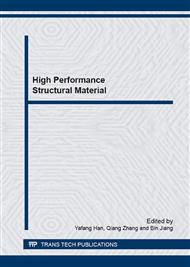p.91
p.96
p.102
p.107
p.113
p.118
p.126
p.133
p.138
Tunable Electromagnetic Properties of Yttrium Iron Garnet Ceramics
Abstract:
Different porosity Y3Fe5O12 (YIG) ceramics (32% - 62%) were prepared from ceramic powders, which was synthesised by high temperature solid-phase reactions, and the effects of porosity on their electromagnetic properties were investigated. XRD and SEM were used to analyze the phase composition and microstructure of the porous composites. Electromagnetism properties including alternate current conductivity, permittivity and permeability of the composites were tested by HP4991 impedance analyzer (10 MHz~1 GHz). The results indicated that, the porosity and pore diameter were increasing with the addition of pore former by pressureless sintering; the real permeability and permittivity of YIG ceramic decreased when the porosity increasing, at the same time, the peaks of magnetic loss were moved to high frequency. That is to say, the electromagnetism properties of YIG ceramic composites could be adjusted by its porosity. Yttrium iron garnet ceramic can be widely used for high frequency devices due to its excellent and tunable magnetic properties.
Info:
Periodical:
Pages:
113-117
Citation:
Online since:
April 2015
Authors:
Keywords:
Price:
Сopyright:
© 2015 Trans Tech Publications Ltd. All Rights Reserved
Share:
Citation:


